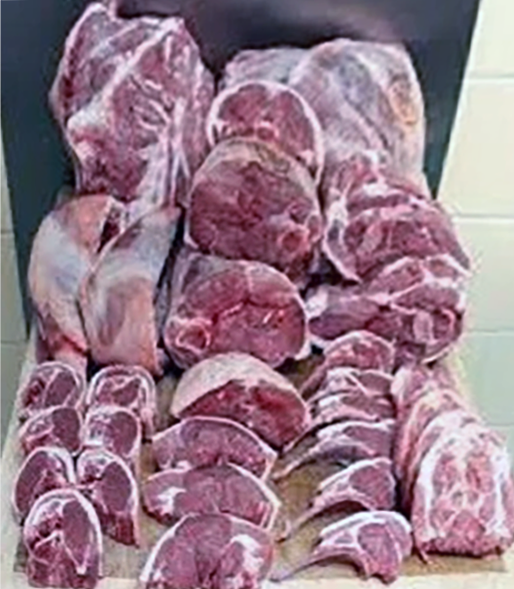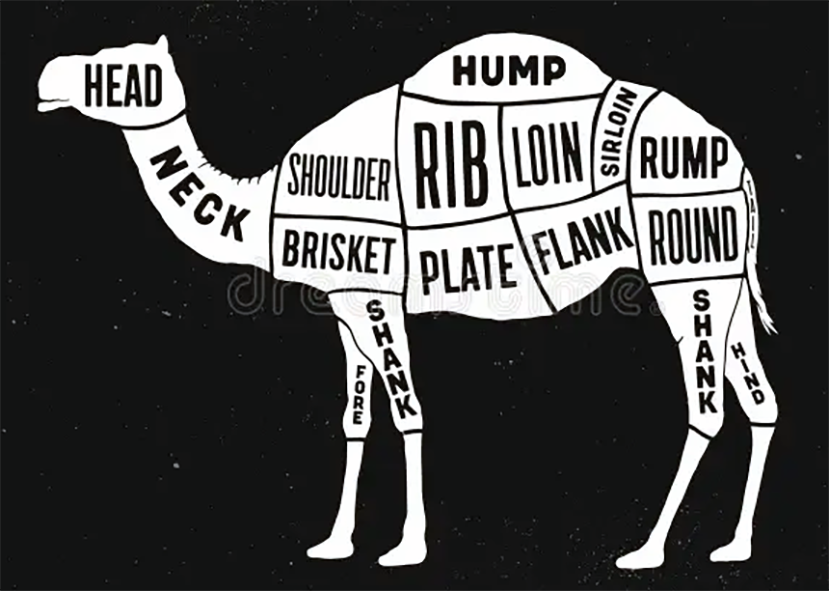FabulousFusionFood's Camel-based Recipes Home Page
 Selection of different fresh camel leat cuts.
Selection of different fresh camel leat cuts.
Welcome to FabulousFusionFood's Camel-based Recipes Page — The recipes presented here are all based on camel meat. Camel represents a young camels, typically the dromedary, (Camelus dromedarius); older animals are also eaten, but the meat tends to be tougher, requiring prolonged cooking to make it tender.
A camel (from Latin: camelus and Ancient Greek: κάμηλος (kamēlos) from Ancient Semitic: gāmāl is an even-toed ungulate in the genus Camelus that bears distinctive fatty deposits known as "humps" on its back. Camels have long been domesticated and, as livestock, they provide food (camel milk and meat) and textiles (fibre and felt from camel hair). Camels are working animals especially suited to their desert habitat and are a vital means of transport for passengers and cargo. There are three surviving species of camel. The one-humped dromedary makes up 94% of the world's camel population, and the two-humped Bactrian camel makes up 6%. The wild Bactrian camel is a distinct species that is not ancestral to the domestic Bactrian camel, and is now critically endangered, with fewer than 1,000 individuals.
The word camel is also used informally in a wider sense, where the more correct term is "camelid", to include all seven species of the family Camelidae: the true camels (the above three species), along with the 'New World' camelids: the llama, the alpaca, the guanaco, and the vicuña, which belong to the separate tribe Lamini. Camelids originated in North America during the Eocene, with the ancestor of modern camels, Paracamelus, migrating across the Bering land bridge into Asia during the late Miocene, around 6 million years ago.
The earliest known camel, called Protylopus, lived in North America 40 to 50 million years ago (during the Eocene). It was about the size of a rabbit and lived in the open woodlands of what is now South Dakota. By 35 million years ago, the Poebrotherium was the size of a goat and had many more traits similar to camels and llamas. The hoofed Stenomylus, which walked on the tips of its toes, also existed around this time, and the long-necked Aepycamelus evolved in the Miocene. The split between the tribes Camelini, which contains modern camels and Lamini, modern llamas, alpacas, vicuñas, and guanacos, is estimated to have occurred over 16 million years ago.
The ancestor of modern camels, Paracamelus, migrated into Eurasia from North America via Beringia during the late Miocene, between 7.5 and 6.5 million years ago. During the Pleistocene, around 3 to 1 million years ago, the North American Camelidae spread to South America as part of the Great American Interchange via the newly formed Isthmus of Panama, where they gave rise to guanacos and related animals. Populations of Paracamelus continued to exist in the North American Arctic into the Early Pleistocene. This creature is estimated to have stood around 2.7 metres tall. The Bactrian camel diverged from the dromedary about 1 million years ago, according to the fossil record.
Like horses, camels originated in North America and eventually spread across Beringia to Asia during the late Miocene glaciation. They survived in the Old World, and eventually humans domesticated them and spread them globally. Along with many other megafauna in North America, the original wild camels were wiped out during the spread of the first indigenous peoples of the Americas from Asia into North America, 10 to 12,000 years ago; although fossils have never been associated with definitive evidence of hunting.
Bactrian camels in Central Asia, for example, face freezing winters and scorching summers. They are suitably adapted though, with thick fur keeping them warm when it gets cold. This coat quickly sheds when their environment starts to warm up again. Camels have historically been suited to colder weather, with evidence of now extinct species found in the Arctic Circle. Indeed, camels were almost certainly originally cold-adapted and evolved for frigid tundra environments. Indeed, one of the camels' adaptations to prevent sinking in sand originally evolved to prevent sinking in snow. Rather than small hooves, camels are equipped with wide snowshoe-like feet with two toes. The large size and round shape of their feet help camels to distribute their weight, preventing them from sinking.
Most camels surviving today are domesticated. Although feral populations exist in Australia, India and Kazakhstan, wild camels survive only in the wild Bactrian camel population of the Gobi Desert.
When humans first domesticated camels is disputed. Dromedaries may have first been domesticated by humans in Somalia or South Arabia sometime during the 3rd millennium BC, the Bactrian in central Asia around 2,500 BC, as at Shar-i Sokhta (also known as the Burnt City), Iran. A study from 2016, which genotyped and used world-wide sequencing of modern and ancient mitochondrial DNA (mtDNA), suggested that they were initially domesticated in the southeast Arabian Peninsula, with the Bactrian type later being domesticated around Central Asia.
 The extant species of camel: Wild Bactrian camel Camelus ferus (left); Bactrian camel
The extant species of camel: Wild Bactrian camel Camelus ferus (left); Bactrian camelCamelus bactrianus (centre) and Dromedary Camelus dromedarius (right).
Camel milk can readily be made into yogurt, but can only be made into butter if it is soured first, churned, and a clarifying agent is then added. Until recently, camel milk could not be made into camel cheese because rennet was unable to coagulate the milk proteins to allow the collection of curds. However in the 1990s, curdling was induced by the addition of calcium phosphate and vegetable rennet. The cheese produced from this process has low levels of cholesterol and is easy to digest, even for the lactose intolerant. Camel milk can also be made into ice cream.
Approximately 3.3 million camels and camelids are slaughtered each year for meat worldwide. A camel carcass can provide a substantial amount of meat. The male dromedary carcass can weigh 300–400 kg, while the carcass of a male Bactrian can weigh up to 650 kg. The carcass of a female dromedary weighs less than the male, ranging between 250 and 350 kg. The brisket, ribs, loin and rump are among the preferred parts, and the hump is considered a delicacy. The hump contains 'white and sickly fat', which can be used to make the khli (preserved meat) of mutton, beef, or camel. From chemical composition to meat quality, the dromedary camel is the preferred breed for meat production. It does well even in arid areas due to its unusual physiological behaviours and characteristics, which include tolerance to extreme temperatures, radiation from the sun, water paucity, rugged landscape and low vegetation. Camel meat is reported to taste like coarse beef, but older camels can prove to be very tough, although camel meat becomes tenderer the more it is cooked.
Camel meat has been eaten for centuries. It has been recorded by ancient Greek writers as an available dish at banquets in ancient Persia, usually roasted whole. The Roman emperor Heliogabalus enjoyed camel's heel. Camel meat is mainly eaten in certain regions, including Mauritania, Eritrea, Somalia, Djibouti, Saudi Arabia, the United Arab Emirates, Egypt, Syria, Libya, Sudan, Ethiopia, Kazakhstan and Australia, along with other arid regions where alternative forms of protein may be limited or where camel meat has had a long cultural history.
Australia has exported camel meat, primarily to the Middle East but also to Europe and the US, for many years. The meat is very popular among East African Australians, such as Somalis, and other Australians have also been buying it. The feral nature of the animals means they produce a different type of meat to farmed camels in other parts of the world.
There are approximately 14 million camels alive as of 2010, with 90% being dromedaries. Dromedaries alive today are domesticated animals (mostly living in the Horn of Africa, the Sahel, Maghreb, Middle East and South Asia). The Horn region alone has the largest concentration of camels in the world, where the dromedaries constitute an important part of local nomadic life. They provide nomadic people in Somalia and Ethiopia with milk, food, and transportation.
Over one million dromedary camels are estimated to be feral in Australia, descended from those introduced as a method of transport in the 19th and early 20th centuries. This population is growing about 8% per year; it was estimated at 700,000 in 2008. Representatives of the Australian government have culled more than 100,000 of the animals in part because the camels use too much of the limited resources needed by sheep farmers.
Cuts of Camel:
 Cuts of Camel:
Cuts of Camel:Neck — stewing
Shoulder — stewing
Brisket — stewing
Shank — stewing
Rib — braising, stewing, barbecuing
Plate — stewing, braising
Loin (including chops, racks and saddle) — roasting, frying, braising
Flank — frying
Barnsley chop, a large double loin chop — frying
Leg (gigot in Scotland) including leg steaks — roasting, frying
Sirloin — frying, braising
Rump — roasting Round — braising
Offal — typically tongue, liver, heart, stomach, sweetbreads, testicles, intestines and kidneys
The alphabetical list of all the Camel-based recipes on this site follows, (limited to 100 recipes per page). There are 36 recipes in total:
Page 1 of 1
| Assegas n Tajin s Ifrawen (Camel tagine with dried apricots) Origin: Western Sahara | Camel Meat Patties Origin: Mauritania | Kebab with Garlic Origin: Western Sahara |
| Australian Camel Stew Origin: Australia | Camel Nihari Origin: Pakistan | Libyan Camel Meatballs Origin: Libya |
| Basto and Suugo Origin: Somalia | Camel Reshmi Kabab Origin: Pakistan | Maafe (Meat Peanut Stew) Origin: Mali |
| Basto and Suugo Origin: Djibouti | Camel roast Origin: Fusion | Mrefisa Origin: Western Sahara |
| Camel Aussie Burger Origin: Australia | Camel Seekh Kabab Origin: Bangladesh | Mughlai-style Camel Curry Origin: India |
| Camel Braise with Grilled Date Glace Origin: Fusion | Camel Steak with Allspice Origin: Fusion | Muqmad (Djibouti Preserved Meat) Origin: Djibouti |
| Camel Chubbagin Origin: Mauritania | Cholistani Karahi Origin: Pakistan | Oodkac (Somali Preserved Meat) Origin: Somalia |
| Camel Curry Origin: Pakistan | Dromedary Tibs Origin: Djibouti | Samboussa (Djibouti Samosas) Origin: Djibouti |
| Camel Haunch Steaks with Chips Origin: Britain | Fried Camel Origin: UAE | Shinwari Karahi Origin: Pakistan |
| Camel Kebabs with Harissa Sauce Origin: Western Sahara | Hilib Ari (Somali Camel Meat Kebabs) Origin: Somalia | Sous Vide of Camel Ribs Origin: Fusion |
| Camel Meat Patties Origin: Libya | Hilib Ari (Djibouti Camel Meat Kebabs) Origin: Djibouti | Special Nihari Origin: Pakistan |
| Camel Meat Patties Origin: Djibouti | Hilib Ari (Somaliland Camel Meat Kebabs) Origin: Somaliland | Tajine de chameau aux abricots secs (Camel tagine with dried apricots) Origin: Mali |
Page 1 of 1